Ralph E. Vaughan's Blog, page 9
March 26, 2013
Dust Off Your Classics!

When my kids were still in school (so very long ago), I would mention to them from time to time to be sure to read books of their own choosing, and to judge books on their own merits using their own judgement. I also told them occasionally not to let other people (i.e., teachers) make decisions for them; the corollary to that, of course, is: "Don't be put off any book just because a teacher tells you that it is good or great, and definitely do not let the term classic be the kiss of death for an author whose greatest sin is trying to tell you a good story." I think that's really good advice for us all, and now Diamond Cronen, of the Dee's Reads book blog, and Bookish Trish, of the Between the Lines blog, have issued a challenge to all readers -- "Dust Off Your Classics!"
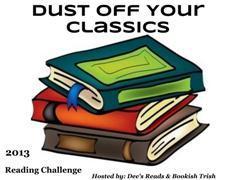 Dee's Reads
Dee's ReadsBetween the LinesSo, why should you add a single classic to your to-be-read list, much less the six that the challenge calls for? That's not really as complicated as you might think, at least from my point of view. To me, you read a so-called "classic" for the same reason you would any other book -- to be a better person (literate people are not ignorant or uninteresting), and because we all love a good story. But exactly what six books are you going to choose to as your answer to the challenge...now, that is complicated, for one person's classic is another person's potboiler, which is exactly what some of the books now considered classics were called (or worse) when first published. I'm going to list my choices below, and perhaps you'd like to share your own preferences; by the way, if you are an insatiable reader and are not registered with Good Reads, what's wrong with you?

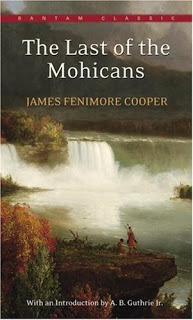
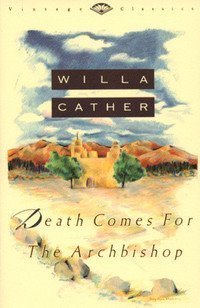

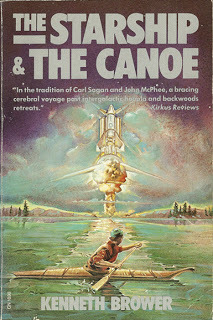
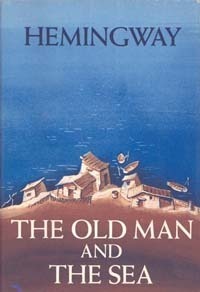
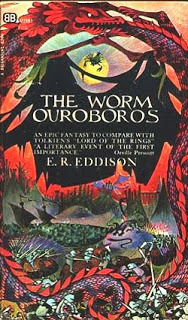
Yes, you can count, and so can I. The 2013 Dust Off Your Classics Reading Challenge from Dee and Trish call for six, and I've listed seven. Sorry, I don't like even numbers.
Published on March 26, 2013 23:17
March 20, 2013
Sherlock Holmes & The Coils of Time (Redux)
Back in 2005, Gryphon Books of Brooklyn, N.Y., published my book Sherlock Holmes in The Coils of Time, in which the Great Detective, just risen from his supposed death at the Reichenbach Fall three years previously, teams with H.G. Wells' Time Traveller to save Victorian London (and us modern folk) from an invasion by the cannibalistic Morlocks of the distant future. Since I've already written something about the joy and trial of collaborating with Wells and Conan Doyle. we need not rehash that here, nor the success the story had in Germany and Croatia. But I do want to tell you about how the Gryphon Books edition had a tragic intersection with Hurricane Sandy (AKA "Superstorm Sandy") in 2012.
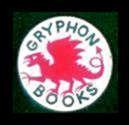
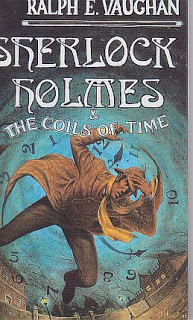 Gary Lovisi, owner of Gryphon Books, and I have known each other for 30+ years, ever since he published my first modest Sherlock Holmes opus, Sherlock Holmes in The Adventure of the Ancient Gods, in which an elderly Holmes meets fantasy writer H.P. Lovecraft at the height of his creative powers and becomes involved with the highly destructive cosmic creatures of the so-called Cthulhu Mythos. We did not know it at the time, but what seemed a quite logical variation on the usual pastiche (logical to us anyway) had never been done before, but that was then, and we want to move toward to when Gary published the Sherlock Holmes/Time Traveller pastiche. As with all the books published by Gryphon Books, copies of The Coils of Time were stored in the basement of Gary's house, a place that had never been flooded in all the history of Brooklyn. All that changed, however, when Hurricane Sandy came to town. His basement became a surging maelstrom of water and mud an event Gary relates quite poignantly in the news section of his website.
Gary Lovisi, owner of Gryphon Books, and I have known each other for 30+ years, ever since he published my first modest Sherlock Holmes opus, Sherlock Holmes in The Adventure of the Ancient Gods, in which an elderly Holmes meets fantasy writer H.P. Lovecraft at the height of his creative powers and becomes involved with the highly destructive cosmic creatures of the so-called Cthulhu Mythos. We did not know it at the time, but what seemed a quite logical variation on the usual pastiche (logical to us anyway) had never been done before, but that was then, and we want to move toward to when Gary published the Sherlock Holmes/Time Traveller pastiche. As with all the books published by Gryphon Books, copies of The Coils of Time were stored in the basement of Gary's house, a place that had never been flooded in all the history of Brooklyn. All that changed, however, when Hurricane Sandy came to town. His basement became a surging maelstrom of water and mud an event Gary relates quite poignantly in the news section of his website.
While the Federal government is more than willing to dole out money lavishly to labor unions and political cronies, a small press institution does not fall into that category; and I suppose New Englanders trying to get money from their insurance companies and the tight-fisted FEMA would have some stories to tell as well. Of course, no amount of money can make a disaster, even a minor one, "like it never happened," despite the trite and patronizing slogan of a well-known insurance company. And that's especially true when it comes to decades of publishing and collecting. So, with just about everything lost (including my books) Gryphon Books is looking forward, but not back...i.e., I'm out of print.
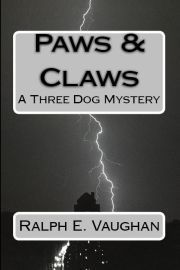
Had it not been for National Novel Writing Month (NaNoWriMo), which I wrote about late last year, I probably would have just sighed about the loss of The Coils of Time and the other books, and figured, "Well, that's that." However, in November 2012, as part of NaNoWriMo, I wrote Paws & Claws: A Three Dog Mystery, a trio of real Scoobies, and by completing that month of "literary abandon" I came into contact with Create Space, a POD business run by Amazon, through which I published my thoroughly uncommercial (and apparently very popular) tale of detective doggies. So, I decided to take a second plunge into the waters and bring The Coils of Time back from the dead.

However, I wanted to more than just re-print that old 2005 story. Needless to say, I planned on correcting any flubs that made it into the old book and of course revising the text to make it flow better and be more logical, but I wanted to do more. I wanted it to be a whole new reading experience, which meant writing new stories to go with the old one, so I did what I often do when I have ideas but no plots...I jotted down titles, and after I oodles of them, I whittled them down to a half-dozen and commenced to write."The Long-Suffering Landlady" -- Having Sherlock Holmes as a lodger could not have been an easy matter, especially back in the Victorian and Edwardian Eras when a landlady was actually more like a servant who collected rent. In about a thousand words, I referenced more than twenty Holmes stories and also fitted in nods to HPL and Professor Challenger."An Incident in the Night" -- Originally, this was supposed to be "Doctor Watson's Afghanistan Adventure," but when a title comes to you too quickly and sounds too good (just as in the naming of a character), check it out. A similar title was already in use, and though my story would have been nothing like that which was already published, I decided to take a different tack, setting my story on the HMS Orontes, during Watson's long voyage back to London in 1880."Lestrade and the Lost River Pirates" -- the odd thing about this little tale of Inspector Lestrade's attempt to solve a series of seemingly impossible crimes is that as soon as I had the title I had the plot, probably because I have long been interested in London's "lost rivers." But there are always surprises, even with tales that spring forth like Athena from the brow of Zeus, and that came in the form of the highly eccentric and possibly dotty character Miss Eliza Cookwell of Lower Westbourne Court, London, and her basement filled with the effluvia of empires."The Man Who Was Not Sherlock Holmes" -- In this story, I descended into comedy. While some of the other stories are decidedly light-hearted, I wanted this tale of actor Reginald Sterling, who just got the sack after playing the lead in the 1950s BBC series Sherlock Holmes of Baker Street for three years, to bring at least a smile to readers' lips, and perhaps even a chuckle or two."The Adventure of the Counterfeit Martian" -- This take on Sherlock Holmes during the War of the Worlds invasion (Manly Wade Wellman previously [1975] wrote on the same theme) went very well as far as plotting, but neither Holmes nor the Martians helped at all when it came to keeping the tale true to my original title, "The Adventure of the Martian Eye." So I did what authors always do when faced with mutinying characters...I surrendered. And, so, instead of encountering cosmic vistas of horror, Holmes learns to walk like a Martian."The Dog Who Loved Sherlock Holmes" -- Levi, the Dachshund-mix detective from Paws & Claws, helped me out with this one. Given his fondness for the Great Detective, it did not take much effort to convince him to channel his inner Sherlock Holmes in this poignant tale of love, courage and detection."Sherlock, HPL, Gary & Me" -- Not a story, this one, but an essay about the Sherlock Holmes pastiches I wrote for Gryphon Books. Nowadays, people who were in the small press movement of the 1970's - 1990's are being asked for their memories; now that most of all that has gone away, scholars are beginning to set down histories, and the publications that have survived, all those magazines of limited circulation and duration, only tell a fraction of the story, and many of the people from then are no longer with us. I wanted to chronicle what we did in our little corner of the publishing universe.So, in March 2013, Sherlock Holmes: The Coils of Time & Other Stories was published under the Dog in the Night Books imprint. And since it is inscribed in servers and hard drives, not just recorded on paper, it will not be susceptible to the vagaries of an angry planet, and will remain in print until the lights go out in the world for the last time.

 Gary Lovisi, owner of Gryphon Books, and I have known each other for 30+ years, ever since he published my first modest Sherlock Holmes opus, Sherlock Holmes in The Adventure of the Ancient Gods, in which an elderly Holmes meets fantasy writer H.P. Lovecraft at the height of his creative powers and becomes involved with the highly destructive cosmic creatures of the so-called Cthulhu Mythos. We did not know it at the time, but what seemed a quite logical variation on the usual pastiche (logical to us anyway) had never been done before, but that was then, and we want to move toward to when Gary published the Sherlock Holmes/Time Traveller pastiche. As with all the books published by Gryphon Books, copies of The Coils of Time were stored in the basement of Gary's house, a place that had never been flooded in all the history of Brooklyn. All that changed, however, when Hurricane Sandy came to town. His basement became a surging maelstrom of water and mud an event Gary relates quite poignantly in the news section of his website.
Gary Lovisi, owner of Gryphon Books, and I have known each other for 30+ years, ever since he published my first modest Sherlock Holmes opus, Sherlock Holmes in The Adventure of the Ancient Gods, in which an elderly Holmes meets fantasy writer H.P. Lovecraft at the height of his creative powers and becomes involved with the highly destructive cosmic creatures of the so-called Cthulhu Mythos. We did not know it at the time, but what seemed a quite logical variation on the usual pastiche (logical to us anyway) had never been done before, but that was then, and we want to move toward to when Gary published the Sherlock Holmes/Time Traveller pastiche. As with all the books published by Gryphon Books, copies of The Coils of Time were stored in the basement of Gary's house, a place that had never been flooded in all the history of Brooklyn. All that changed, however, when Hurricane Sandy came to town. His basement became a surging maelstrom of water and mud an event Gary relates quite poignantly in the news section of his website.While the Federal government is more than willing to dole out money lavishly to labor unions and political cronies, a small press institution does not fall into that category; and I suppose New Englanders trying to get money from their insurance companies and the tight-fisted FEMA would have some stories to tell as well. Of course, no amount of money can make a disaster, even a minor one, "like it never happened," despite the trite and patronizing slogan of a well-known insurance company. And that's especially true when it comes to decades of publishing and collecting. So, with just about everything lost (including my books) Gryphon Books is looking forward, but not back...i.e., I'm out of print.

Had it not been for National Novel Writing Month (NaNoWriMo), which I wrote about late last year, I probably would have just sighed about the loss of The Coils of Time and the other books, and figured, "Well, that's that." However, in November 2012, as part of NaNoWriMo, I wrote Paws & Claws: A Three Dog Mystery, a trio of real Scoobies, and by completing that month of "literary abandon" I came into contact with Create Space, a POD business run by Amazon, through which I published my thoroughly uncommercial (and apparently very popular) tale of detective doggies. So, I decided to take a second plunge into the waters and bring The Coils of Time back from the dead.

However, I wanted to more than just re-print that old 2005 story. Needless to say, I planned on correcting any flubs that made it into the old book and of course revising the text to make it flow better and be more logical, but I wanted to do more. I wanted it to be a whole new reading experience, which meant writing new stories to go with the old one, so I did what I often do when I have ideas but no plots...I jotted down titles, and after I oodles of them, I whittled them down to a half-dozen and commenced to write."The Long-Suffering Landlady" -- Having Sherlock Holmes as a lodger could not have been an easy matter, especially back in the Victorian and Edwardian Eras when a landlady was actually more like a servant who collected rent. In about a thousand words, I referenced more than twenty Holmes stories and also fitted in nods to HPL and Professor Challenger."An Incident in the Night" -- Originally, this was supposed to be "Doctor Watson's Afghanistan Adventure," but when a title comes to you too quickly and sounds too good (just as in the naming of a character), check it out. A similar title was already in use, and though my story would have been nothing like that which was already published, I decided to take a different tack, setting my story on the HMS Orontes, during Watson's long voyage back to London in 1880."Lestrade and the Lost River Pirates" -- the odd thing about this little tale of Inspector Lestrade's attempt to solve a series of seemingly impossible crimes is that as soon as I had the title I had the plot, probably because I have long been interested in London's "lost rivers." But there are always surprises, even with tales that spring forth like Athena from the brow of Zeus, and that came in the form of the highly eccentric and possibly dotty character Miss Eliza Cookwell of Lower Westbourne Court, London, and her basement filled with the effluvia of empires."The Man Who Was Not Sherlock Holmes" -- In this story, I descended into comedy. While some of the other stories are decidedly light-hearted, I wanted this tale of actor Reginald Sterling, who just got the sack after playing the lead in the 1950s BBC series Sherlock Holmes of Baker Street for three years, to bring at least a smile to readers' lips, and perhaps even a chuckle or two."The Adventure of the Counterfeit Martian" -- This take on Sherlock Holmes during the War of the Worlds invasion (Manly Wade Wellman previously [1975] wrote on the same theme) went very well as far as plotting, but neither Holmes nor the Martians helped at all when it came to keeping the tale true to my original title, "The Adventure of the Martian Eye." So I did what authors always do when faced with mutinying characters...I surrendered. And, so, instead of encountering cosmic vistas of horror, Holmes learns to walk like a Martian."The Dog Who Loved Sherlock Holmes" -- Levi, the Dachshund-mix detective from Paws & Claws, helped me out with this one. Given his fondness for the Great Detective, it did not take much effort to convince him to channel his inner Sherlock Holmes in this poignant tale of love, courage and detection."Sherlock, HPL, Gary & Me" -- Not a story, this one, but an essay about the Sherlock Holmes pastiches I wrote for Gryphon Books. Nowadays, people who were in the small press movement of the 1970's - 1990's are being asked for their memories; now that most of all that has gone away, scholars are beginning to set down histories, and the publications that have survived, all those magazines of limited circulation and duration, only tell a fraction of the story, and many of the people from then are no longer with us. I wanted to chronicle what we did in our little corner of the publishing universe.So, in March 2013, Sherlock Holmes: The Coils of Time & Other Stories was published under the Dog in the Night Books imprint. And since it is inscribed in servers and hard drives, not just recorded on paper, it will not be susceptible to the vagaries of an angry planet, and will remain in print until the lights go out in the world for the last time.
Published on March 20, 2013 15:48
March 14, 2013
Anthology Hounds
 Bennett CerfNovels sell very well, and most commercial fiction (i.e., it pays the bills) is in the novel format. Collections of short stories by established writers do not sell as well, but they are bought by fans. Anthologies generally do not sell very well at all, and when they appear they are usually targeted to a specific sliver of the reading public -- Sherlock Holmes fans, Lovecraft fans, ghost story fans, locked-room murder mystery fans, and the like; anthologies not ensconced in a specific genre are aimed at academic and library audiences. Despite the relative poor sales figures for anthologies, they are still edited and published for an ever-dwindling audience that yet appreciates the short story, endangered species of the literary world. I always wondered what to call those of us who still like diving into anthologies, and finally got an answer a few weeks ago when reading Bennett Cerf's introduction to his 1945 Modern American Short Stories anthology:
Bennett CerfNovels sell very well, and most commercial fiction (i.e., it pays the bills) is in the novel format. Collections of short stories by established writers do not sell as well, but they are bought by fans. Anthologies generally do not sell very well at all, and when they appear they are usually targeted to a specific sliver of the reading public -- Sherlock Holmes fans, Lovecraft fans, ghost story fans, locked-room murder mystery fans, and the like; anthologies not ensconced in a specific genre are aimed at academic and library audiences. Despite the relative poor sales figures for anthologies, they are still edited and published for an ever-dwindling audience that yet appreciates the short story, endangered species of the literary world. I always wondered what to call those of us who still like diving into anthologies, and finally got an answer a few weeks ago when reading Bennett Cerf's introduction to his 1945 Modern American Short Stories anthology:The cheering knowledge that this book is intended solely to provide amusement for the reader, and that there is no thought whatever of providing a textbook or pretentious "survey of the short story in America," permitted the editor to range as far afield as he liked in his choice of contents. This will explain at one time the inclusion of certain stories that are decidedly unorthodox and the omission of a few trusty warhorses reprinted so often that inveterate anthology hounds can recite them in their sleep.Anthology Hounds? I think that's a pretty apt description of our literary mentality. If you know anything about the dog world (if you don't like dogs, you might as well tell me you don't like books either so I can shun you with a clear conscience), you know the hound holds a special place among breeds in that they "track or chase the quarry sought," and they do not give up until they find what they are looking for, whether it's a duck, a raccoon or an escaped convict trying to lose a posse in the bayou. On the other hand, Coonhounds and Bloodhounds may not be quite as tenacious as Anthology Hounds.
I find myself reading anthologies quite often, but I rarely list them among the books I read and review for GoodReads.com. Except for certain anthologies (Steampunk and The Great Detective: His Further Adventures were the last two), I rarely read them all the way through. I'm in for three or four stories, then on to something else, but I always know I'll be back, over and over. But even finishing an anthology means little, for a good Anthology Hound will always return.
It would be a fool's task to make any kind of a "best anthology" list. A hundred people assembling a list of the top ten anthologies would quickly discover they had a hundred different top-ten lists, no prospect of compromise, and fights to the death would quickly break out. However, I want share some anthologies that I've truly enjoyed; maybe you could do the same.
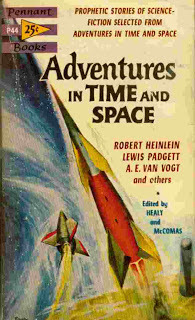 I recall quite distinctly buying Healy & MacComas' Adventures in Time and Space in 1962 at the National City Swap Meet. It was one of several dozen used books on a rickety wire spinner (do you recall those?) and I got it for a dime. It was a hot clear blue day but as I sat at one of the tables where food was sold and started reading, the sky darkened and became full of stars, a rocket ship dropped out of space, and its descent was watched keenly by the last surviving member of a race that had hunted all other life on the planet to extinction. It's an amazing collection of stories, which I have now in hardcover and which I still delve into from time to time. First published in 1946, it collected the best of the science fiction published up to that time, stories which still remain as relevant now as they were back then. All of the stories made something of an impact on me back then (and most still have that power) but several stand out. There is "Black Destroyer" by A.E. van Vogt, the story referred to above, "The Sands of Time" by P. Schuyler Miller in which time comes around and we end up chasing ourselves, "Nightfall" by Isaac Asimov in which a planet that has never known night experiences starlight for the first time, Harry Bates' "Farewell to the Master" which was filmed as the less effective The Day the Earth Stood Still, van Vogt's amazing "The Weapon Shop," and Lewis Padgett's menacingly humorous "The Twonky." Despite the passage of time and innumerable anthologies published since then, it remains a colossal achievement. I might even go as far as to say it's the best SF anthology ever...but I don't want people to throw things at me.
I recall quite distinctly buying Healy & MacComas' Adventures in Time and Space in 1962 at the National City Swap Meet. It was one of several dozen used books on a rickety wire spinner (do you recall those?) and I got it for a dime. It was a hot clear blue day but as I sat at one of the tables where food was sold and started reading, the sky darkened and became full of stars, a rocket ship dropped out of space, and its descent was watched keenly by the last surviving member of a race that had hunted all other life on the planet to extinction. It's an amazing collection of stories, which I have now in hardcover and which I still delve into from time to time. First published in 1946, it collected the best of the science fiction published up to that time, stories which still remain as relevant now as they were back then. All of the stories made something of an impact on me back then (and most still have that power) but several stand out. There is "Black Destroyer" by A.E. van Vogt, the story referred to above, "The Sands of Time" by P. Schuyler Miller in which time comes around and we end up chasing ourselves, "Nightfall" by Isaac Asimov in which a planet that has never known night experiences starlight for the first time, Harry Bates' "Farewell to the Master" which was filmed as the less effective The Day the Earth Stood Still, van Vogt's amazing "The Weapon Shop," and Lewis Padgett's menacingly humorous "The Twonky." Despite the passage of time and innumerable anthologies published since then, it remains a colossal achievement. I might even go as far as to say it's the best SF anthology ever...but I don't want people to throw things at me.
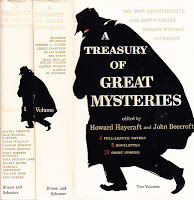 Both these great Treasury of... anthologies (each a 2-volume set) came to me through book clubs, the Science Fiction Book Club and the Mystery Book Club. Back in those days, to get the introductory offer you listed your choices, taped your dime to the response card, mailed it, and got your swag in a couple weeks. The clubs still work much the same way as they did, but, as you might guess, the dime is history. Although the genres are different the anthologies were produced at about the same time, cover the same period of American & British writing, and have similar formats -- a mix of short stories and novel-length tales, an advantage of being spread over two volumes. That there is some genre crossover between the two anthologies is hardly surprising as mystery and science fiction have always been kissing cousins.
Both these great Treasury of... anthologies (each a 2-volume set) came to me through book clubs, the Science Fiction Book Club and the Mystery Book Club. Back in those days, to get the introductory offer you listed your choices, taped your dime to the response card, mailed it, and got your swag in a couple weeks. The clubs still work much the same way as they did, but, as you might guess, the dime is history. Although the genres are different the anthologies were produced at about the same time, cover the same period of American & British writing, and have similar formats -- a mix of short stories and novel-length tales, an advantage of being spread over two volumes. That there is some genre crossover between the two anthologies is hardly surprising as mystery and science fiction have always been kissing cousins.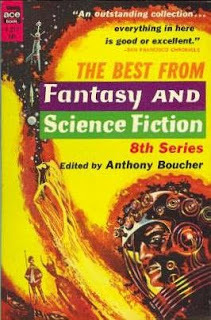 For years and years, I bought each volume of the annual F&SF best-of anthology, even though I was a long-time subscriber and had all the stories already. While I did not always agree with the editor (who does?) the stories were always of the highest quality. F&SF was hardly the only magazine to issue annual best-of collections, for in those days the newsstand was packed with digest-sized (sometimes larger) fiction magazines, and many could be counted on for collections, if not annually, then at least once before they went to magazine heaven. Some that stick with me are Galaxy's and Analog's several books, the If Science Fiction Reader, the annual collections from Ellery Queen Mystery Magazine and Alfred Hitchcock Mystery Magazine (not to be confused with the anthologies edited by Alfred Hitchcock himself), the Amazing Stories anthology, and Fantastic Magazine's. All the magazines (even those not producing anthologies) were fertile breeding grounds for stories to be later found in one or more of the many best-of-the-genre collections issued every year, and some of my favorite series were The Best Science Fiction of the Year, Star Science Fiction Series, The Annual World's Best SF and Year's Best SF. The mystery genre also had its best-of collections, such as the annual Edgar anthologies issued by the MWA, which were always unusual because they rarely restricted themselves to a single year. Genre magazines are now, unfortunately, almost gone and no longer play a major role in filling the two remaining best-of mystery and science fiction anthologies. If you look through the copyright pages (I always do) of Otto Penzler's Best American Mystery Short Stories or Gardner Dozois' The Year's Best Science Fiction, you will note that the inclusions come from just about everywhere except genre magazines.
For years and years, I bought each volume of the annual F&SF best-of anthology, even though I was a long-time subscriber and had all the stories already. While I did not always agree with the editor (who does?) the stories were always of the highest quality. F&SF was hardly the only magazine to issue annual best-of collections, for in those days the newsstand was packed with digest-sized (sometimes larger) fiction magazines, and many could be counted on for collections, if not annually, then at least once before they went to magazine heaven. Some that stick with me are Galaxy's and Analog's several books, the If Science Fiction Reader, the annual collections from Ellery Queen Mystery Magazine and Alfred Hitchcock Mystery Magazine (not to be confused with the anthologies edited by Alfred Hitchcock himself), the Amazing Stories anthology, and Fantastic Magazine's. All the magazines (even those not producing anthologies) were fertile breeding grounds for stories to be later found in one or more of the many best-of-the-genre collections issued every year, and some of my favorite series were The Best Science Fiction of the Year, Star Science Fiction Series, The Annual World's Best SF and Year's Best SF. The mystery genre also had its best-of collections, such as the annual Edgar anthologies issued by the MWA, which were always unusual because they rarely restricted themselves to a single year. Genre magazines are now, unfortunately, almost gone and no longer play a major role in filling the two remaining best-of mystery and science fiction anthologies. If you look through the copyright pages (I always do) of Otto Penzler's Best American Mystery Short Stories or Gardner Dozois' The Year's Best Science Fiction, you will note that the inclusions come from just about everywhere except genre magazines.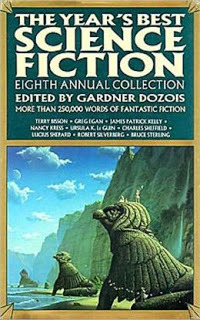

As the magazines began to die off, we saw a rise in anthologies containing fiction written specifically for the particular series (for example Universe), usually at the invitation of the editor. While there were several original-fiction anthologies in the 60s and 70s (and almost all genre anthologies are now comprised of nothing but original fiction), the one that has to stand out in everyone's mind, not just because of the quality of the stories but also the attendant controversies, is Harlan Ellison's Dangerous Visions (1967)

As many people have said over the years, "The table of contents reads like a Who's Who of science fiction in the 1960s," and it's a statement no one can reasonably deny. None of the 33 stories in the book had ever appeared in a magazine, but many of them never could have been published in a magazine of the time. It may have been Endless Summer and Free Love in society, but magazines of the time still clung to boys clubs and twin beds -- if you read science fiction magazines, you could become reasonably proficient in time travel, faster-than-light spaceships, alien psychology and particle physics, but the birds and the bees would have just been terrestrial animals. Though time has dimmed the impact of some of these tales, I still remember quite fondly Fritz Leiber's "Gonna Roll the Bones" and Ellison's "The Prowler in the City at the Edge of the World." Ellison published the sequel Again, Dangerous Visions in 1972, containing even more stories that could never have been published anywhere else...though of course they were published elsewhere because the anthologies had broken down the barriers. Ellison planned for the ultimate shout at the world in The Last Dangerous Visions, but it is likely destined to become the most famous anthology never published.
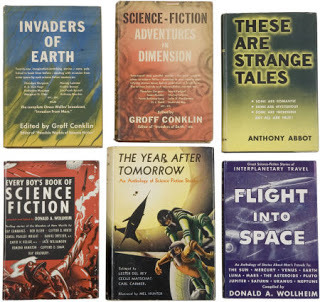
Of course, as mentioned earlier, everybody has a favorite anthology, a different list of best-of anthologies and justifications for the choices, sometimes having to do with the quality of the stories, the literary importance of the anthology, or the prestige of the writers included. But sometimes the reasons are personal and even peculiar. For example, I like Invaders of Earth, one of Groff Conklin's numerous anthologies, not just because the stories are great and I like alien-invasion tales, but because it saved me from drowning in a pond in the heartland of America. I'm sure you have similar stories.
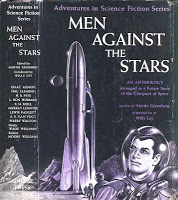
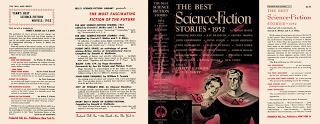
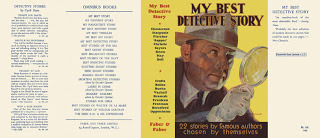
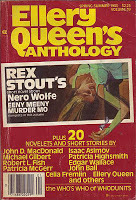
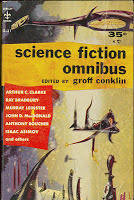
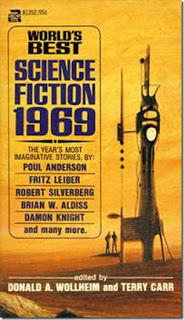
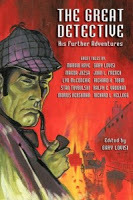
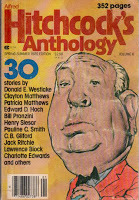
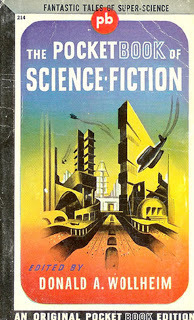
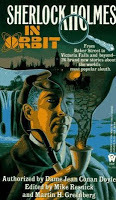
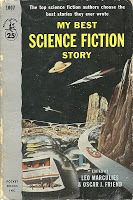
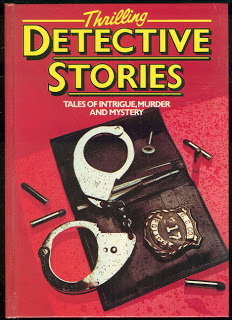
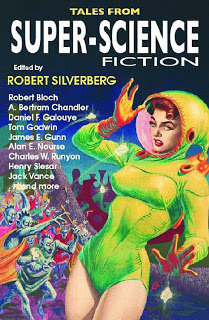
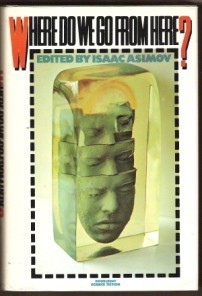
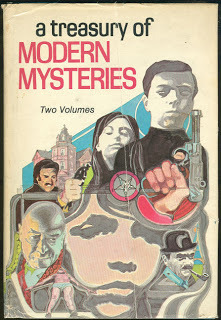
Published on March 14, 2013 15:22
February 21, 2013
Of Concrete Blondes and the Garden of Earthly Delights
 "Try The Concrete Blonde," the homeless guy told me. "It's really good, and, besides, Slick Willie likes it."
"Try The Concrete Blonde," the homeless guy told me. "It's really good, and, besides, Slick Willie likes it.""Slick Willie?"
"Yeah, Slick Willie...ya know -- Clinton," he said with a deep chuckle. "Some popza snapped a pic with the Blonde under his arm. At least Hillary can't chuck him in the doghouse 'bout this babe cuz she's just a book; Connelly's books don't suck."
It was sometime in the mid-90s, dusk had settled on the City by the Sea, and the homeless guy was a fellow I often saw at the Library on Fridays, which was when the Friends of the Library had their book sales. Larry, the homeless guy, and me might be worlds apart on most everything, but we could talk books, and often did.
As usual, I was extolling the virtues of mystery writers decades entombed, and venting about the lack of good modern writers. Sure, you had your Joe Wambaughs, Elmore Leonards, and Robert Parkers. but where were the Ellery Queens, Rex Stouts and John Dickson Carrs? Where were the J.J. Marrics? The Leslie Charterises? The Raymond Chandlers? Sure, thrillers and action and bloodletting by the gallon, but where were the writers who still practiced in the classic mode, still believed in fair play, still had their knights of justice patrol mean streets without themselves being touched by the darkness? So, he suggested The Concrete Blonde, Michael Connelly's third book chronicling the world of LAPD Detective Hieronymus "Harry" Bosch, the first two being Black Echo (1992) and Black Ice (1993). I read it, and Larry was right -- Connelly's book didn't suck.
 Michael Connelly (l), playing poker with (l to r) James Patterson, Stephen J. Cannell,
Michael Connelly (l), playing poker with (l to r) James Patterson, Stephen J. Cannell, and the supposedly fictional mystery author Richard Castle.Michael Connelly, a former crime reporter for the Los Angeles Times, has managed to write a Harry Bosch novel every year or two, totally to 19 with the publication of The Gods of Guilt in 2013. In a recent interview with Mystery Scene Magazine, Connelly said, "When I wrote my first novel twenty years ago, I never guessed that I'd be writing about the same character twenty years later."
 Two paintings by artist Hieronymus Bosch, after whom Connelly's detective was named. Though
Two paintings by artist Hieronymus Bosch, after whom Connelly's detective was named. ThoughBosch lived hundreds of years ago, one could almost believe he had seen modern Los Angeles.Harry Bosch, a Vietnam vet, has a moral code that has kept him out of trouble as often as it has plunged him into trouble. When Connelly wrote Black Echo -- he was still a crime reporter with the Times who depended upon the good will of the LAPD for him to do his job -- he worried that the book might alienate his police contacts, but, as it turned out, the opposite was true. The good cops either saw themselves in Harry Bosch or saw someone they would want to be, a modern knight errant who walked through tides of evil without being sucked under.
Over the years, I've read all the Harry Bosch novels, though not always in the order written (there were some spoilers but nothing egregious), and I have to admit to being very fond of Harry. Bosch is yet another example of why our best heroes are fictional. And he's become quite real to many people.
 Harry Bosch's house overlooking the Hollywood Freeway.Not only is Harry Bosch fully fleshed out as a character, but the Los Angeles through which he moves is the same darkness-infested city in which Connelly worked as a crime reporter, a city revealed to perfection in the video Blue Neon Nights: Michael Connelly's Los Angeles, a promotion received by those who bought The Narrows (2004); one of the most interesting moments in that video is when Chief of Police William J. Bratton announces at an official function that Harry Bosch, who had retired due to moral conflicts, would return to the LAPD thanks to a special program that allowed recently retired detectives to work for a limited time at their old jobs. As far as I know, that is the only time a fictional character (or is he fictional?) was asked by the LAPD to return to duty. If that does not impart a sense of verisimilitude to Harry Bosch beyond what can be reasonably expected through an author's mere words, I don't know what does. Unlike other series detectives (such as Nero Wolfe or Ellery Queen), Harry Bosch always works in the present, and ages at a normal rate -- the debacle with Rodney King happened just as long ago for Harry as for us. Lacking flashbacks and stories set in earlier times (as Conan Doyle did with The Hound of the Baskervilles), we can expect the last Harry Bosch novel to be sometime around 2016, when his new retirement date (it has already been extended twice and is at the maximum allowed) goes into effect. One hopes that it will not, of course, be the end of Harry Bosch, but all things, good and bad, must eventually end...it's the way of the world, even, it seems, in Harry Bosch's world.
Harry Bosch's house overlooking the Hollywood Freeway.Not only is Harry Bosch fully fleshed out as a character, but the Los Angeles through which he moves is the same darkness-infested city in which Connelly worked as a crime reporter, a city revealed to perfection in the video Blue Neon Nights: Michael Connelly's Los Angeles, a promotion received by those who bought The Narrows (2004); one of the most interesting moments in that video is when Chief of Police William J. Bratton announces at an official function that Harry Bosch, who had retired due to moral conflicts, would return to the LAPD thanks to a special program that allowed recently retired detectives to work for a limited time at their old jobs. As far as I know, that is the only time a fictional character (or is he fictional?) was asked by the LAPD to return to duty. If that does not impart a sense of verisimilitude to Harry Bosch beyond what can be reasonably expected through an author's mere words, I don't know what does. Unlike other series detectives (such as Nero Wolfe or Ellery Queen), Harry Bosch always works in the present, and ages at a normal rate -- the debacle with Rodney King happened just as long ago for Harry as for us. Lacking flashbacks and stories set in earlier times (as Conan Doyle did with The Hound of the Baskervilles), we can expect the last Harry Bosch novel to be sometime around 2016, when his new retirement date (it has already been extended twice and is at the maximum allowed) goes into effect. One hopes that it will not, of course, be the end of Harry Bosch, but all things, good and bad, must eventually end...it's the way of the world, even, it seems, in Harry Bosch's world. Harry Bosch's Los Angeles is so real, you can map it.
Harry Bosch's Los Angeles is so real, you can map it.
Published on February 21, 2013 17:30
February 9, 2013
It's a Noir Noir World
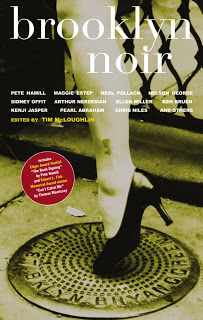 Akashic Books is an independent publisher based in Brooklyn, N.Y., so it's quite appropriate that in 2004 it started its widely acclaimed noir anthology series with a collection of short stories set in their own backyard. Since then, the company has published about fifty anthologies set in various cities in the US and around the world; some cities are so filled with darkness, crime and desperation that Akashic has re-visited them with a second anthology -- San Francisco, Los Angeles (of course!), Manhattan, Brooklyn (three, actually), Boston, and Washington D.C.
Akashic Books is an independent publisher based in Brooklyn, N.Y., so it's quite appropriate that in 2004 it started its widely acclaimed noir anthology series with a collection of short stories set in their own backyard. Since then, the company has published about fifty anthologies set in various cities in the US and around the world; some cities are so filled with darkness, crime and desperation that Akashic has re-visited them with a second anthology -- San Francisco, Los Angeles (of course!), Manhattan, Brooklyn (three, actually), Boston, and Washington D.C.Noir is from the French and means black, (you know, like how real coffee is supposed to be) and was first applied to pre- and post-war crime films that abounded in shadows, dark streets, femme fatales, and world-weary gumshoes willing to battle evil for thirty bucks a day, plus expenses. From the silver screen, it's just a hop and a skip down a grimy alley to the printed page. It's no use trying to define what noir is, if only because everyone has his own idea of what it is (and isn't), what is central to the genre and what's out of bounds, so anyone who tries to pin it down is a fool...but we're all fools from time to time, especially me. All that anybody can be sure of, if you're a fan of noir fiction, you need a steady and reliable supply, and if you don't get it, you're like a grifter without a con, or a tout without a racing form.
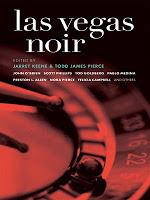
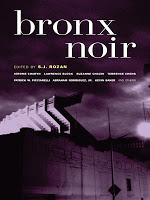
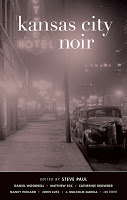
If you're looking for noir fiction to go along with your bourbons on the rocks, there are always plenty of novels from which to choose, from the works of James M. Cain, Raymond Chandler and Patricia Highsmith to modern practitioners like James Ellroy, Dennis Lehane and Michael Connelly. But for short fiction? We find our way back to Akashic Books. Since the anthologies are themed by geography, the stories are a form of regionalism, but with the emphasis on crime, hustlers and dames, the stories are not the sort likely to ever have come from the pens of Robert Frost, Edith Wharton or August Derleth. The appeal of Akashic's approach is that you can probably find the city you live in (or near), a city you've visited (or wanted to), or a city that is the equivalent of a "soul-mate." The drawback, of course, is that if you go solely by city preferences then you might miss a killer story.
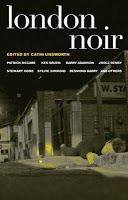
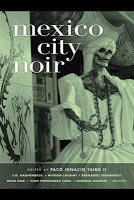
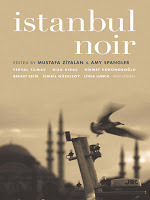
The world being what it is, the United States is not the only place you'll find desperate characters, and Akashic has several titles to prove it. Now, an argument can be made that it's all really just a marketing gimmick, a ploy to get you buy books that you might otherwise pass by, that since every story must have a setting, it really doesn't matter where they're set. But that's not the case when regionalism and noir collide, for a tale of lust and desperation set among the surfers and dog-walkers of San Diego's Ocean Beach can't be transplanted to Brooklyn's Brighton Beach with its middle class Jews and Russian Mafia ex-pats; a crime story with the tempo of Soho neon just doesn't work in Istanbul's ancient backstreets. When regionalistic noir works (and it does in Akashic's series much more often than not) we end up with a gritty and fascinating tale that could not be set anywhere else but where it's set, a story where the city is integral to the plot and is just as much a character as any guy or doll. Several volumes are in the planning stages at Akashic, with one, USA Noir, scheduled for release on 5 November 2013. Until then, find your noir city and settle down to some great reads. After all, it's a noir noir world...
Published on February 09, 2013 14:49
February 2, 2013
Honoring Local Authors: San Diego
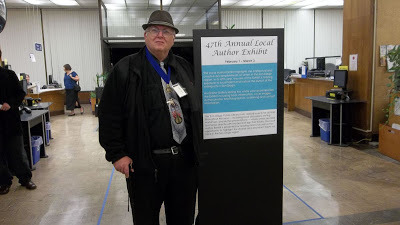 Me and a defenseless sign that could not run away
Me and a defenseless sign that could not run awayLast night (1 February 2013), I attended a reception at the San Diego Public Library. The occasion was the 47th Annual Local Authors Exhibit, recognizing those who had had books published (including e-books) during 2012. I was in good company, as there were some 330 authors, representing more than 400 books. The display is open to the public 1 February 2013 - 3 March 2013, and the Library is located at 820 E Street, downtown San Diego.
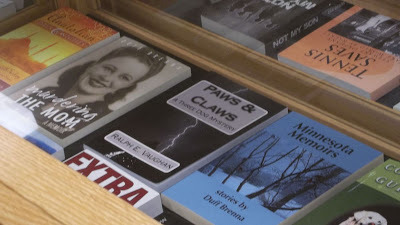 Yes, there it is, the real reason everyone was there...to see
Yes, there it is, the real reason everyone was there...to seea copy of Paws & Claws: A Three Dog Mystery.The range of books was nothing short of amazing -- fiction of all sorts, memoirs, biography, satire, history, science, cookbooks, children's and Young Adult, self-help, health, religion & spirituality, geography, crafts, animals, literature, poetry, and politics. The writers themselves were just as varied, of all races, religions, creeds, and classes. Experience ranged from the professional with dozens of best-sellers under his belt, to the first-time author. The youngest of the group was a lad of just 9 years, and the oldest was...well, the truth is, as long as it wasn't me I'm just fine with any geezer who wants to claim that title. Though I am not much of a schmoozer, I did get a chance to talk with a great many people in attendance, and like all authors they were more than happy to talk about their creations, very much like proud mamas and papas attending the school play, and seeing their own child as the best of the lot.
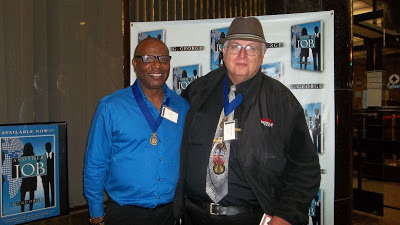 G. George, the author of Another Job, and me, standing in front of
G. George, the author of Another Job, and me, standing in front ofa promotional banner for his book outside the Library.One of the beaming writers was G. George, who wrote the spiritual novel Another Job, the story of a family who suffers through the sort of trials and tribulations that afflicted the Biblical Job, a man whose faith in God was tested sorely, who not only had to suffer the ills tossed him by the Devil, but also the best intentions of his friends. G is a good example of the writer who believes in himself and his book, and is not shy about promoting both. Outside the Library he erected a very large promotional screen and displayed some posters, and was passing out some very well-designed book-markers to everyone as we waited in line to be processed in. No matter what you think of his book (and it seems great to me from what I've read so far) it's hard to argue with such enthusiasm and confidence. G's book is available in hardcover, softcover, and as an e-book, from your local bookstore (if you still have one near you) and the current Goliath of booksellers, Amazon.
 Most books were displayed flat in floor cases
Most books were displayed flat in floor cases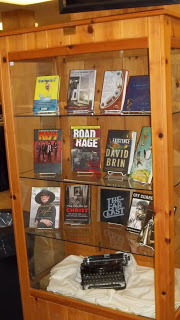 The Pros
The Pros
 Some of the books were spotlighted in smaller cases
Some of the books were spotlighted in smaller cases Someone mentioned "free food" and authors came running; the only thing that would have caused a bigger rush is if someone had said "free booze"
Someone mentioned "free food" and authors came running; the only thing that would have caused a bigger rush is if someone had said "free booze"
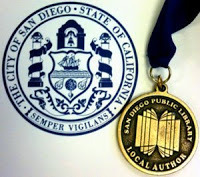 The medal
The medal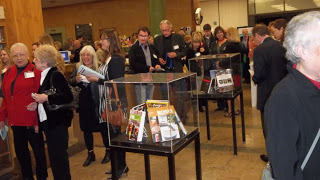 More display cases, and the authors in line to be awarded their medals.
More display cases, and the authors in line to be awarded their medals.The most interesting aspect of the evening to me was the increase in the number of writers present and books written over years past. When I was still with the Friends of the Library and was responsible for writing the checks (neither the City nor the Library uses tax money for this), the number of books submitted was well under two hundred, and had decreased from the previous year. Not being involved with the planning of this year's event I was caught unawares, and was a little shocked, by the increase. What's the reason for it? Well, it's certainly not the economy -- moribund is much too optimistic a description of current conditions, and at least 40% of the population is unemployed. And it can't be because of a surfeit of bookstores -- Borders bit the dust, as did Waldenbooks, and Barnes & Noble just announced they're closing at least 60 stores. Are people reading more? I know that people who had given up reading are now getting back into the habit, and mostly because of e-books. And self-publishing is now easier and more economical (especially on Amazon's Create-Space platform) and is not considered such a banal act of vanity as it once was. Then there's social media, which can spread information about a new book just as fast as friends, and friend-of-friends-of-friends, can click "like." Even well-established authors find it beneficial (even necessary) to have a Facebook page. Regular readers know I have often decried the rise of electronic publishing, considering it a factor in the end of civilization as we know it; while my Luddite heart still tells me I am right, it also seems to be whispering, "It may not be all that bad after all."
Published on February 02, 2013 11:46
January 23, 2013
Book Giveaway
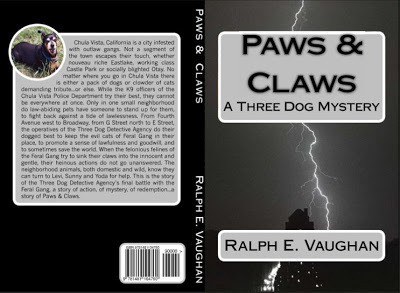
Paws & Claws: A Three Dog Mystery is being listed as a giveaway on the GoodReads website. If you like a chance to win one of five autographed proof copies, please register with GoodReads (it's free) and then go to the giveaways section. The giveaway will close on 23 February 2013, at which time the winners will be chosen at random by GoodReads.com
.goodreadsGiveawayWidget { color: #555; font-family: georgia, serif; font-weight: normal; text-align: left; font-size: 14px; font-style: normal; background: white; } .goodreadsGiveawayWidget img { padding: 0 !important; margin: 0 !important; } .goodreadsGiveawayWidget a { padding: 0 !important; margin: 0; color: #660; text-decoration: none; } .goodreadsGiveawayWidget a:visted { color: #660; text-decoration: none; } .goodreadsGiveawayWidget a:hover { color: #660; text-decoration: underline !important; } .goodreadsGiveawayWidget p { margin: 0 0 .5em !important; padding: 0; } .goodreadsGiveawayWidgetEnterLink { display: block; width: 150px; margin: 10px auto 0 !important; padding: 0px 5px !important; text-align: center; line-height: 1.8em; color: #222; font-size: 14px; font-weight: bold; border: 1px solid #6A6454; -moz-border-radius: 5px; -webkit-border-radius: 5px; font-family:arial,verdana,helvetica,sans-serif; background-image:url(http://www.goodreads.com/images/layou... background-repeat: repeat-x; background-color:#BBB596; outline: 0; white-space: nowrap; } .goodreadsGiveawayWidgetEnterLink:hover { background-image:url(http://www.goodreads.com/images/layou... color: black; text-decoration: none; cursor: pointer; } Goodreads Book Giveaway
 Paws & Claws by Ralph E. Vaughan
Paws & Claws by Ralph E. Vaughan Giveaway ends February 23, 2013.
See the giveaway details at Goodreads.
Enter to win
Published on January 23, 2013 17:59
December 30, 2012
Ear Poetry
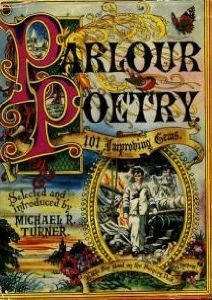 It's a bit of a cliched image, the young lad standing ramrod straight and dressed in his best Victorian finery, at the front of the parlour before enduring guests and adoring family, reciting classic poetry of the highest moral rectitude, poems "with plain, easy rhythms, uncomplicated heroics and unabashed pathos." Modern society may look back upon such activity with a mix of amusement and mockery, but I think we may be missing something of value, for poetry has a way of making us face aspects of our culture we would rather ignore. And poetry is at its strongest when delivered in a clear, strong voice bereft of moral uncertainty.
It's a bit of a cliched image, the young lad standing ramrod straight and dressed in his best Victorian finery, at the front of the parlour before enduring guests and adoring family, reciting classic poetry of the highest moral rectitude, poems "with plain, easy rhythms, uncomplicated heroics and unabashed pathos." Modern society may look back upon such activity with a mix of amusement and mockery, but I think we may be missing something of value, for poetry has a way of making us face aspects of our culture we would rather ignore. And poetry is at its strongest when delivered in a clear, strong voice bereft of moral uncertainty.Unfortunately, not only has the high tide of poetry passed, revealing jagged shoals, but very little modern poetry is intended to be read aloud. Indeed, try to recite most current poems and your tongue will either fall off or you'll Gibbs-slap yourself with it. The poems most successful in verbal performance today are still those gems chosen for recitation by that well-schooled lad in the family parlour. For me, poetry is primarily a verbal tradition; I don't write as many poems as I used to, but when I do write a poem the first thing I do is read it aloud to hear how it sounds. Admittedly, reading a poem is not like reading a short story and takes a different set of skills, but it's well worth the effort.
As our children were growing, we encouraged them to read poems and to recite their favorites to us. I can't say we were entirely successful, but we were as successful as one can be contending against video games, films, television and the myriad other distractions of this digital age. The Kid recited poems about the survivor of the Titanic, the heroics and folly of battle, and the power of Vachel Lindsay's Jungle; above all, the Kidette regaled us with the tale of Poe's "grim, ungainly, ghastly, gaunt and ominous bird of yore" (over and over and over), but she also brought to life Paul Revere's midnight ride, Blake's Tyger burning brightly in the night, and Sandburg's feline "Fog." And they both took a little stroll with the Carpenter and the Walrus, and cavorted with Eliot's Cats. Now, of course, both children are grown and no longer read poetry, but I do hope those forced performances abide with them. They do with me.
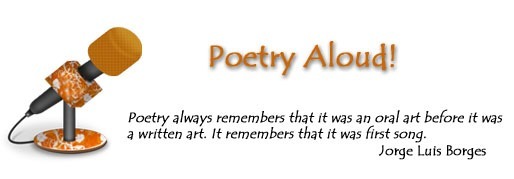
Published on December 30, 2012 15:43
December 9, 2012
England's Glory
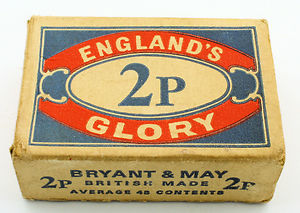
"I started with a matchbox label that read Bryant & May -- England's Glory. That gave me their names, their nationality, and something vague and appealing, the sense of an institution with roots in London's sooty past. I decided that London would be the third character, not the tourist city of guidebooks but the city of invisible societies, hidden parks and drunken theatricals, the people and places I show my friends when the visit. By making my detectives old, I could simultaneously show them as experienced adults and immature children."I am tremendously attracted to any novel set in London, but especially mysteries, but what first caught my eye when I saw Full Dark House by Christopher Fowler a few years ago was the contradiction of the title. Because both my children were high school thespians (one was leaving school as the other entered, so I had eight years of it) and the Kidette is still associated with theater as a playwright, I know lots of theater terms (including "stage slap," but that is another story). I know that full house is every producer's goal, with SRO, and that dark house means there's no performance and the theater's empty. So, a full dark house...no performance to SRO?-- Christopher Fowler
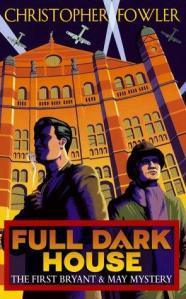 Because I so often come across great mystery series after they have been around awhile (and then have to play hunt-and-seek) I was gratified to start with the first book in the series shortly after it was published in 2003. Here we are introduced to the Peculiar Crimes Unit, an agency started during WW2 to deal with crimes that might cause civil unrest or panic among the population. Leading it then, and now, are Arthur Bryant, London's most senior detective, and John May, who is not much less senior. Bryant and May are a study in contrasts, May being dapper and highly organized, and Bryant being anything but; May embraces technology while Bryant makes a Luddite look like a techno-geek; May employs the latest criminology and police techniques, while Bryant trusts intuition and has been known to call in a dowser or a white witch as a consultant from time to time. For some reason (can't figure out why) I'm more partial to Bryant, who has been known to say such things as "No, I don't have to be rude, but it does help to pass the time," and "I'm going to stuff my brain with information till the day I die, and take it with me." And die is what he does in this first book. Sort of.
Because I so often come across great mystery series after they have been around awhile (and then have to play hunt-and-seek) I was gratified to start with the first book in the series shortly after it was published in 2003. Here we are introduced to the Peculiar Crimes Unit, an agency started during WW2 to deal with crimes that might cause civil unrest or panic among the population. Leading it then, and now, are Arthur Bryant, London's most senior detective, and John May, who is not much less senior. Bryant and May are a study in contrasts, May being dapper and highly organized, and Bryant being anything but; May embraces technology while Bryant makes a Luddite look like a techno-geek; May employs the latest criminology and police techniques, while Bryant trusts intuition and has been known to call in a dowser or a white witch as a consultant from time to time. For some reason (can't figure out why) I'm more partial to Bryant, who has been known to say such things as "No, I don't have to be rude, but it does help to pass the time," and "I'm going to stuff my brain with information till the day I die, and take it with me." And die is what he does in this first book. Sort of.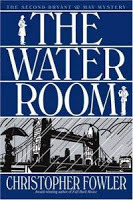 In The Water Room (2004) we have an elderly lady found drowned in her home, her lungs full of river water, very much in the realm of the classic locked room mystery. Whereas the first book gave us hints and flashes of London's secret and hidden history, here it hits us full in he face, as we learn of layers of London history, ancient evils and rivers that flow through caverns measureless to man. Reading Fowler's book, you get the feeling that he imparting actual history to you, but the trouble is deciding what is fact and what is fiction. In his blog, Christopher Fowler has written that it's actually the more obscure and extraordinary aspects of his stories that are either real or only lightly fictionalized. When I read a book from the series, I find it quite handy to keep a copy of William Kent's An Encyclopaedia of London within consulting distance, and it doesn't hurt to have also read John O'London's London Stories.
In The Water Room (2004) we have an elderly lady found drowned in her home, her lungs full of river water, very much in the realm of the classic locked room mystery. Whereas the first book gave us hints and flashes of London's secret and hidden history, here it hits us full in he face, as we learn of layers of London history, ancient evils and rivers that flow through caverns measureless to man. Reading Fowler's book, you get the feeling that he imparting actual history to you, but the trouble is deciding what is fact and what is fiction. In his blog, Christopher Fowler has written that it's actually the more obscure and extraordinary aspects of his stories that are either real or only lightly fictionalized. When I read a book from the series, I find it quite handy to keep a copy of William Kent's An Encyclopaedia of London within consulting distance, and it doesn't hurt to have also read John O'London's London Stories.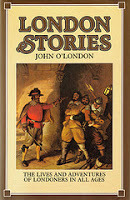
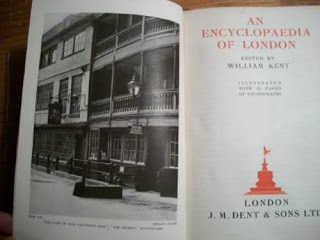
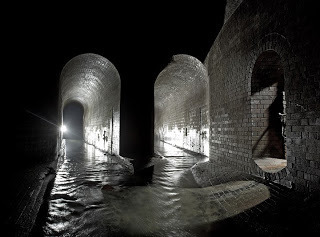 The River Fleet--a "lost" river
The River Fleet--a "lost" riverInitially, the PCU does its business from offices above the Mornington Crescent tube station, a real place, then is forced to relocate to a disreputable warehouse on The Caledonian Road, another very real place. By making use of London's actual psychogeography, he achieves his stated goal or making London the third character of the triptych. Quite often, the two detectives find themselves standing on Waterloo Bridge, discussing cases as they look over the city to which they have devoted most of their lives.
 The View from Waterloo
The View from WaterlooIf you have not already discovered the pleasure of the Bryant & May series, you should give it a try before the list gets too long and before any go out of print. They series consists of...Full Dark House (2003)The Water Room (2004)Seventy-Seven Clocks (2005)Ten Second Staircase (2006)White Corridor (2007)The Victoria Vanishes (2008)Bryant & May on the Loose (2009)Off the Rails (2010)The Memory of Blood (2011)Bryant & May and the Invisible Code (2012)In addition, there is a short story, Bryant & May's Mystery Tour (2011), which is part of the Storycuts program and available to US readers in a Kindle edition. Currently, Fowler is working on The Bleeding Heart, which should be out in 2013, and which I will certainly be looking for.
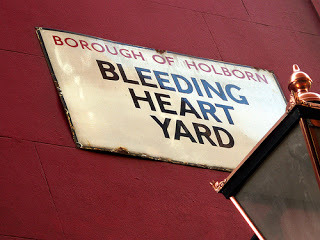
A bit of an addendum to this post and a bonus for Bryant & May fans. Christopher Fowler wrote a very short Christmas story featuring the two elderly detectives of the PCU. Please enjoy.
Published on December 09, 2012 17:02
November 25, 2012
November...The Month of Novels
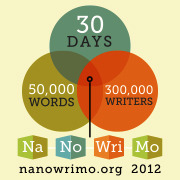 Since we have a day, week or month for everything, seemingly, these days, it come as no surprise that a literary achievement has its own place in the sun as well. November is designated National Novel Writing Month (NaNoWriMo) and unlike other observations it is not celebrated with parades, speeches or feasts, but with the actual writing of a novel at least 50,000 words long, beginning at Midnight on 1 November, finishing no later than 11:59:59 PM on 30 November.
Since we have a day, week or month for everything, seemingly, these days, it come as no surprise that a literary achievement has its own place in the sun as well. November is designated National Novel Writing Month (NaNoWriMo) and unlike other observations it is not celebrated with parades, speeches or feasts, but with the actual writing of a novel at least 50,000 words long, beginning at Midnight on 1 November, finishing no later than 11:59:59 PM on 30 November.The event started in July of 1999 in that most literary of American cities, San Francisco, with a grand total of 21 participants. The creators did it because, as one of the first writers put it, "we wanted to write novels for the same dumb reasons twentysomethings start bands. Because we wanted to make noise. Because we didn’t have anything better to do. And because we thought that, as novelists, we would have an easier time getting dates than we did as non-novelists." By the time the second year rolled around, they had a website, a better title that "just a bunch of people noveling," and 140 participants. They also had a new month -- since July is such a great time to be outdoors (even in SF), they changed it to November when staying out of the weather takes no great incentive.
With each passing year, the participation has increased. In 2011, the number of participants who thought they had a novel in them struggling to get out was 256,618; the number who actually crossed the 50K-word finish line was 36,843.
 Panera Bread
Panera BreadChula Vista Shopping Center
(My Writing Home-Away-From Home)I first heard of the NaNoWriMo competition several years ago from a girl I used to work with at the Library. Actually, she was quite surprised I had never before heard of it, but I'm not surprised since, except for local news stories (usually involving students, geeks with proud mothers, or cultural exhibitionists), actual coverage of the event by the media is lacking. To be fair to journalists, however, it's not really an event you can cover in the traditional way -- despite the website, the organization, the "write-ins" and web forums, novel writing is, at its core, a quiet struggle between a writer and a blank sheet of paper (or its electronic equivalent); it's a race against time, but there is no physical course to run; it's an act of creation, but even if you print it out, it's still just a stack of paper until someone reads it.
In years past, I've considered jumping in, but I always managed to talk myself out of it, citing one reason or another; one year, a kidney stone made the decision for me. This year, I ran out of excuses, and so I leaped into the fray, registering with the website and staying up late on Halloween night so I could begin typing at the stoke of midnight.
Now, as you may know if you are a regular reader of Book Scribbles, I've written novels before, but never had I written one in a month. A month is usually the time I allot to a short story, not just because I am slow, but because I usually have several projects going at the same time, not to mention diversions and distractions. For me, novels were massive things written over the course of many months, sometimes edging into years. A novel in a month? Okay, I thought, but I must be crazy.
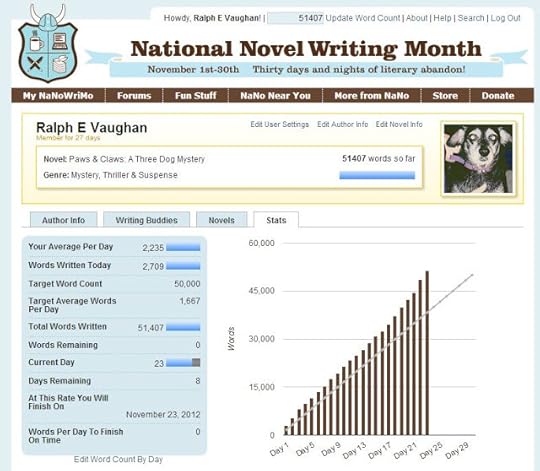
Here's the way it works: as you write your novel, you regularly update your word count on the National Novel Writing Month website. Of course, you can do this whenever you want, but, as they mention on their suggestions page, daily is good because there is a certain thrill and sense of accomplishment in seeing the cumulative word count increase, and your place on the progress graph; equally exciting, however is seeing the "Words Remaining" total decrease day after day. To finish the novel in thirty days, you need to type, on the average 1,667 words/day; each day you can do a little bit more lowers that average and advances your completion date. I started off with a solid 3,000 the first day, so managed to keep ahead of the curve, which was good since there were a few days when I failed to even meet the minimum.
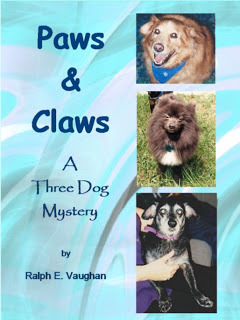 So, what was my novel about (besides 50K words)? I wrote the story of my three dogs -- Sunny, Yoda & Levi -- as detectives in a pitched battle with a local gang of outlaw cats called the Feral Gang. It was a story I had had in mind for some time, even before Levi passed away a few years ago. When you register the title of the novel on the website, you also choose the genre. Because I had talking dogs and cats (not to mention some other critters) I listed it as children's fiction, but I later changed that to Mystery, Thriller & Suspense.
So, what was my novel about (besides 50K words)? I wrote the story of my three dogs -- Sunny, Yoda & Levi -- as detectives in a pitched battle with a local gang of outlaw cats called the Feral Gang. It was a story I had had in mind for some time, even before Levi passed away a few years ago. When you register the title of the novel on the website, you also choose the genre. Because I had talking dogs and cats (not to mention some other critters) I listed it as children's fiction, but I later changed that to Mystery, Thriller & Suspense.The cover you see at the left is not the cover of an actual book, but one I created on the computer for illustration purposes on the NaNoWriMo website. But the dogs on the cover are the actual characters in the novel, and they are probably more responsible for the writing of the novel than am I. An old writing maxim is "Characters make the story," and that more than anything else is what helped me finish the project -- I knew the characters from observing them over a period of twenty years, so all I had to do was present them with situations and conflicts and write down what they said and did. Since they were my pets, I never lost sight of the fact that they were animals and not human surrogates.
At the beginning, I did not think I could do it, especially as the midnight hour approached, but I did. I began work on Paws & Claws: A Three Dog Mystery at 12:01 AM on 1 November 2012; by 2:40 PM on 23 November 2012, I finished typing the last word, "dawning," word number 51,408. The point of all of this, however, is not that I can do it but that you can do it. If you have ever thought, I would like to write a novel, but I don't think I can go it alone, then the structure and encouragement (with its numerous pep talks) of NaNoWriMo may be way you need. Go to the website and plan for 2013. You can do it. I did.
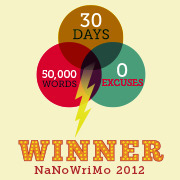
ADDENDUM, 28 NOV 2012: It's difficult to write something like Paws & Claws and not yearn for publication. However, the publishing industry seems to be at a nadir, and then there's the matter of genres. If a story cannot be pigeon holed how to market it. Talking animals? Kidlit? No, not really. Detective? Only if dogs can be detectives to an adult. Fantasy? No, no dragons or chicks in chainmail. It does have religion and redemption, but inspirational niches would be an ill fit indeed. So, what does a optimistic cynic do? Go digital and self publish. I may live to regret it. Or not....regret it, that is. I'll let you know.

Published on November 25, 2012 18:33



